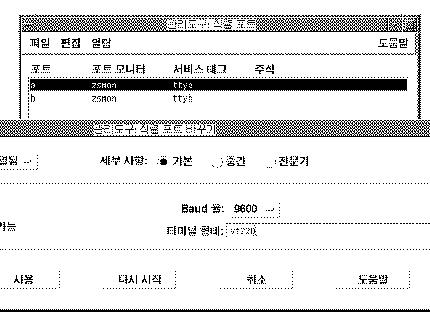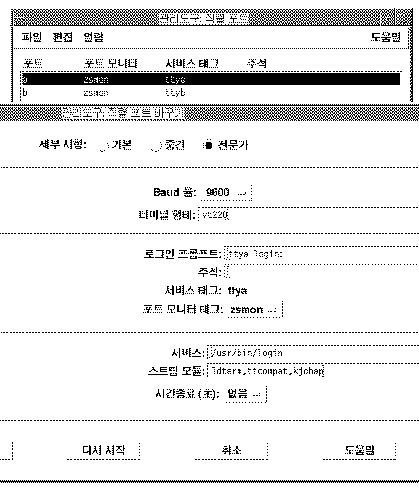Installing a Terminal
If you have not added a terminal to your system before, first try installing a terminal in ASCII mode only. For more information, see System Administration Guide.
Serial Port Interface for Adding Terminals
Serial Ports is available from the Admintool menu to configure serial ports for terminals. Serial Ports provides the easiest method of installing a terminal. Serial Ports is invoked by admintool. For more information on admintool, see System Administration Guide.
Accessing Serial Ports
A Korean terminal that supports KS C 5601 is installed as you would install an ASCII terminal.
-
Become superuser.
system% su
-
Type admintool.
The admintool menu will appear.
system# admintool
-
Select the Serial Ports icon.
-
Select Edit on the Serial Ports menu.
Serial Ports: Modify Service submenu appears.
-
On Admintool: Modify Service submenu select Enabled, Baud Rate 9600, and enter the terminal type.

-
Under Expert Options, select "Create utemp entry" and enter the appropriate module in the Streams Modules field:
To install a terminal that supports the KS C 5601-1987 version of Combination code for the Korean Solaris operating environment, add kpack to the Streams Modules field.
To install a terminal that supports the KS C 5601-1992 version of Combination code for the Korean Solaris operating environment, add kjohap to the Streams Modules field.

Command Line Interface for Adding Terminals
The following procedure is required to set up a terminal on ttya port via the command line:
-
Determine the port monitor version number.
The port monitor version number will display.
# ttyadm -V
-
Enter the following commands, substituting the port monitor version number for ver.
(For more information on sacadm (1M) and pmadm (1M) see their man pages.)
# pmadm -r -p zsmon -s ttya # sacadm -a -p zsmon -t ttymon -c /usr/lib/saf/ttymon -v ver
-
Use the pmadm command that matches your terminal type to add a login service:
For EUC terminals, use the following command:
# pmadm -a -p zsmon -s ttya -i root -fu -v ver -m " `ttyadm -S y \ -T terminal_type -d /dev/ttya -l 9600 -m ldterm,ttcompat -s \ /usr/bin/login`"
For Korean Packed code terminals, which use the KS C 5601-1987 version of Combination code, type the STREAMS module kpack in the ttyadm command:
# pmadm -a -p zsmon -s ttya -i root -fu -v ver -m "`ttyadm -S y \ -T terminal_type -d /dev/ttya -l 9600 -m kpack,ldterm,ttcompat -s \ /usr/bin/login`"
For Korean Combination code terminals, which use the KS C 5601-1992 version of Combination code, type the STREAMS module kjohap in the ttyadm command:
# pmadm -a -p zsmon -s ttya -i root -fu -v ver -m "`ttyadm -S y \ -T terminal_type -d /dev/ttya -l 9600 -m kjohap,ldterm,ttcompat -s \ /usr/bin/login`"
-
Turn on the terminal.
Follow the documentation that accompanies the terminal.
-
Log in the terminal.
-
Check the correctness of the installation:
# setenv LANG ko # /bin/stty cs8 -istrip defeucw
Note -These values show that the operating system is set to communicate with the terminal in "8-bit no-parity" mode. Make sure the terminal is set up in "8-bit no-parity" mode. Refer to the terminal's setup manual for the proper way to set terminal options.
Setting a User's TTY
To verify that your TTY is properly set up:
-
Type the /bin/stty command with the -a option:
system% /bin/stty -a
-
If the values from above (cs8, -istrip) are not listed, then use the following command to set them:
system% /bin/stty cs8 -istrip defeucw
This is the last step in setting up a terminal. The default setting of a Korean terminal is the Completion-code mode. For installing a Packed-code TTY, continue to the next section.
Using Packed Code and Johap TTY in the ko Locale
If you are using a Packed code type terminal, you must load the STREAMS module into the kernel.
-
If you are using a Packed code terminal (KS C 5601-1987), you should load kpack by typing the following command as superuser:
system% su Password: (Type superuser password here if required.) # modload /kernel/strmod/kpack
-
Type the following command:
system% setterm -x PACK
Using Combination Code and Johap TTY in the ko Locale
-
If you are using a Combination code terminal (KS C 5601-1992), load kjohap by typing the following command as superuser:
system% su Password: (Type superuser password here if required.) # modload /usr/kernel/strmod/kjohap
-
Type the following command:
system% setterm -x JOHAP
Using EUC TTY in the ko.UTF-8 Locale
-
If you are using an EUC terminal (KS C 5601-1987-0), load the ku8euc module by typing the following command as superuser:
system% su Password: (Type superuser password here if required.) # modload /kernel/strmod/ku8euc
-
To enable the stream module:
system% setterm -x KU8EUC
-
To enable 8-bit I/O:
system% stty defeucw cs8 -istrip
-
If you want to use dtterm, type the following command:
system% setterm -x u8
Using Johap TTY in the ko.UTF-8 Locale
-
If you are using a Johap code terminal (KS C 5601-1992-3), load the ku8johap module by typing the following command as superuser:
system% su Password: (Type superuser password here if required.) # modload /kernel/strmod/ku8johap
-
To enable the stream module:
system% setterm -x KU8JOHAP
-
To enable 8-bit I/O:
system% stty defeucw cs8 -istrip
-
If you want to use dtterm, type the following command:
system% setterm -x u8
- © 2010, Oracle Corporation and/or its affiliates
